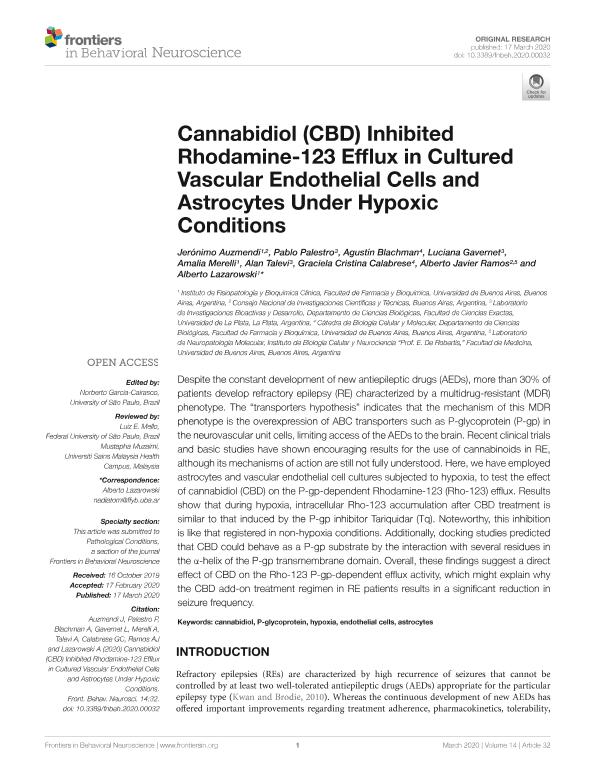Mostrar el registro sencillo del ítem
dc.contributor.author
Auzmendi, Jerónimo Andrés

dc.contributor.author
Palestro, Pablo Hernán

dc.contributor.author
Blachman, Agustin

dc.contributor.author
Gavernet, Luciana

dc.contributor.author
Merelli, Amalia Margarita

dc.contributor.author
Talevi, Alan

dc.contributor.author
Calabrese, Graciela Cristina

dc.contributor.author
Ramos, Alberto Javier

dc.contributor.author
Lazarowski, Alberto Jorge

dc.date.available
2021-06-02T03:31:11Z
dc.date.issued
2020-03-17
dc.identifier.citation
Auzmendi, Jerónimo Andrés; Palestro, Pablo Hernán; Blachman, Agustin; Gavernet, Luciana; Merelli, Amalia Margarita; et al.; Cannabidiol (CBD) inhibited rhodamine-123 efflux in cultured vascular endothelial cells and astrocytes under hypoxic conditions; Frontiers Media S.A.; Frontiers in Behavioral Neuroscience; 14; 32; 17-3-2020; 1-11
dc.identifier.issn
1662-5153
dc.identifier.uri
http://hdl.handle.net/11336/132973
dc.description.abstract
Despite the constant development of new antiepileptic drugs (AEDs), more than 30% of patients develop refractory epilepsy (RE) characterized by a multidrug-resistant (MDR) phenotype. The “transporters hypothesis” indicates that the mechanism of this MDR phenotype is the overexpression of ABC transporters such as P-glycoprotein (P-gp) in the neurovascular unit cells, limiting access of the AEDs to the brain. Recent clinical trials and basic studies have shown encouraging results for the use of cannabinoids in RE, although its mechanisms of action are still not fully understood. Here, we have employed astrocytes and vascular endothelial cell cultures subjected to hypoxia, to test the effect of cannabidiol (CBD) on the P-gp-dependent Rhodamine-123 (Rho-123) efflux. Results show that during hypoxia, intracellular Rho-123 accumulation after CBD treatment is similar to that induced by the P-gp inhibitor Tariquidar (Tq). Noteworthy, this inhibition is like that registered in non-hypoxia conditions. Additionally, docking studies predicted that CBD could behave as a P-gp substrate by the interaction with several residues in the α-helix of the P-gp transmembrane domain. Overall, these findings suggest a direct effect of CBD on the Rho-123 P-gp-dependent efflux activity, which might explain why the CBD add-on treatment regimen in RE patients results in a significant reduction in seizure frequency.
dc.format
application/pdf
dc.language.iso
eng
dc.publisher
Frontiers Media S.A.

dc.rights
info:eu-repo/semantics/openAccess
dc.rights.uri
https://creativecommons.org/licenses/by/2.5/ar/
dc.subject
ASTROCYTES
dc.subject
CANNABIDIOL
dc.subject
ENDOTHELIAL CELLS
dc.subject
HYPOXIA
dc.subject
P-GLYCOPROTEIN
dc.subject.classification
Farmacología y Farmacia

dc.subject.classification
Medicina Básica

dc.subject.classification
CIENCIAS MÉDICAS Y DE LA SALUD

dc.title
Cannabidiol (CBD) inhibited rhodamine-123 efflux in cultured vascular endothelial cells and astrocytes under hypoxic conditions
dc.type
info:eu-repo/semantics/article
dc.type
info:ar-repo/semantics/artículo
dc.type
info:eu-repo/semantics/publishedVersion
dc.date.updated
2021-05-28T16:03:50Z
dc.journal.volume
14
dc.journal.number
32
dc.journal.pagination
1-11
dc.journal.pais
Suiza

dc.description.fil
Fil: Auzmendi, Jerónimo Andrés. Universidad de Buenos Aires. Facultad de Farmacia y Bioquímica. Instituto de Fisiopatología y Bioquímica Clínica; Argentina. Consejo Nacional de Investigaciones Científicas y Técnicas; Argentina
dc.description.fil
Fil: Palestro, Pablo Hernán. Universidad Nacional de La Plata. Facultad de Ciencas Exactas. Laboratorio de Investigación y Desarrollo de Bioactivos; Argentina. Consejo Nacional de Investigaciones Científicas y Técnicas. Centro Científico Tecnológico Conicet - La Plata; Argentina
dc.description.fil
Fil: Blachman, Agustin. Universidad de Buenos Aires. Facultad de Farmacia y Bioquímica. Departamento de Ciencias Biológicas; Argentina
dc.description.fil
Fil: Gavernet, Luciana. Universidad Nacional de La Plata. Facultad de Ciencas Exactas. Laboratorio de Investigación y Desarrollo de Bioactivos; Argentina. Consejo Nacional de Investigaciones Científicas y Técnicas. Centro Científico Tecnológico Conicet - La Plata; Argentina
dc.description.fil
Fil: Merelli, Amalia Margarita. Universidad de Buenos Aires. Facultad de Farmacia y Bioquímica. Instituto de Fisiopatología y Bioquímica Clínica; Argentina
dc.description.fil
Fil: Talevi, Alan. Universidad Nacional de La Plata. Facultad de Ciencas Exactas. Laboratorio de Investigación y Desarrollo de Bioactivos; Argentina. Consejo Nacional de Investigaciones Científicas y Técnicas. Centro Científico Tecnológico Conicet - La Plata; Argentina
dc.description.fil
Fil: Calabrese, Graciela Cristina. Universidad de Buenos Aires. Facultad de Farmacia y Bioquímica. Departamento de Ciencias Biológicas; Argentina
dc.description.fil
Fil: Ramos, Alberto Javier. Consejo Nacional de Investigaciones Científicas y Técnicas. Oficina de Coordinación Administrativa Houssay. Instituto de Biología Celular y Neurociencia "Prof. Eduardo de Robertis". Universidad de Buenos Aires. Facultad de Medicina. Instituto de Biología Celular y Neurociencia; Argentina
dc.description.fil
Fil: Lazarowski, Alberto Jorge. Universidad de Buenos Aires. Facultad de Farmacia y Bioquímica. Instituto de Fisiopatología y Bioquímica Clínica; Argentina
dc.journal.title
Frontiers in Behavioral Neuroscience
dc.relation.alternativeid
info:eu-repo/semantics/altIdentifier/url/https://www.frontiersin.org/article/10.3389/fnbeh.2020.00032/full
dc.relation.alternativeid
info:eu-repo/semantics/altIdentifier/doi/http://dx.doi.org/10.3389/fnbeh.2020.00032
Archivos asociados
